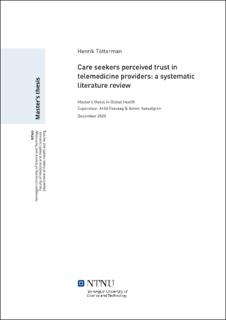| dc.description.abstract | Abstract
Background
Telemedicine is the use of telecommunication technologies, to provide health-related services and -information over a distance. Evaluation and treatment are some areas telemedicine can be used for. This allows the care seeker and healthcare providers (HCP) to communicate without the need of physically meeting. For this communication to be profitable, trust is needed between the two parties. Trust is an important factor in both in face-to-face as in telemedical meetings. It has been shown that patients with increased trust in the HCP report increased satisfaction in care, less symptoms, higher quality of life and more.
Aim, objective and method
Due to the rise of telemedicine use, especially during the Covid-19 pandemic, there is a need for a closer look of the current scientific literature in order to better understand how trust is perceived by patients in telemedical settings. The aim is to review the current knowledge in trust between a care seeker and a caregiver who use telemedical tools to communicate. The study focuses on the interpersonal trust between the two people. A qualitative content analysis was used for this study. 5 online databases were systematically searched using relevant search terms. Strict inclusion and exclusion criteria were established before the searches.
Results
The searches generated 1974 relevant hits. 45 articles were found through snowball method. From these articles, 52 were chosen for further inspection based on title, abstract and/or subject. 19 were chosen from the snowball group. From the 71 articles, 9 were chosen after a thorough read through, for the final analysis based on the inclusion and exclusion criteria. 8 main themes and 1 sub theme were identified.
Conclusion
Trust can play an important role in satisfaction, the outcome and the patient-HCP relationship. A prior face-to-face meeting is beneficial for both parties, as it lays the basis for trust building. Telemedicine can be used as a means to enhance this trust. Continuity and regularity were also found to be important for building and maintaining trust. Telemedicine tools can be both a barrier for establishing trust, as well as a facilitator for it. More time, less hassle around, and the option to choose as well as a caring and focused HCPs are some of the positive facilitators. Studies included had limited age and demographics inclusion. The research done in this area is also limited. Further research is still needed in order to gain comprehensive knowledge of patients trust in HCP in telemedical environments. | |
